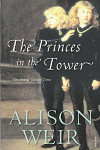Alison Weir – The Princes In The Tower
Posted 28th May 2010
Category: Reviews Genres: 1990s, Historical, Political
1 Comment

I will say now that I believe Richard III to have instigated the murders of Edward V and his brother. But regardless I was after more debate and another’s decision on the subject, someone with more information than me.
Publisher: Vintage
Pages: 258
Type: Non-Fiction
Age: Adult
ISBN: 978-0-099-52696-4
First Published: 1992
Date Reviewed: 25th May 2010
Rating: 2.5/5
What happened to Edward V and his brother the Duke of York has been the subject of speculation for centuries and their purported death in the late 1400’s material for many debates. Richard III, their uncle, wanted the throne – but did he kill them? He had usurped the crown from Edward already – all he had to do was keep the children locked up. Then was it Henry VII who took the crown from Richard, wanting to make sure the old line wouldn’t try to overturn the ruling? Or were the Princes left in the Tower indefinitely and died of natural causes?
I looked to Weir’s book on the subject because I’d read two of her non-fiction works before, The Six Wives Of Henry VIII and Children Of England and even though she has gained from me the nickname “The Hitherto Woman” for her excessive use of the word, I regard her publications as a staple part of my Tudor studies.
In the foreword Weir announces that she will look at the evidence for and against objectively – I relished these words because a debate was just what I was after, but alas it was not to be. At first glance the book shows promise, Weir has grand designs and will do her best to give all the accounts and evidence. She provides a thorough grounding in the background of the family and plenty of information on how Richard could have come to be so cruel. She is definitely right to have assumptions here, Richard’s childhood was full of violence and hatred and as has often been the case throughout history, a background such as this promotes the perversion of an otherwise innocent mind.
The characters are given a lot of space. We hear plenty on Richard, as discussed, Elizabeth Wydville, the heirs of Elizabeth’s union with Edward IV, most of the related gentry, and those first involved with Henry VII. There is detail enough to know quite well the personalities of each. Weir documents the period from Edward IV’s reign (including his own battles for the crown) to the time the rumours died down during the Tudor dynasty, adding information about the discovery of the bodies and the latest forensic work done in modern times – which was in 1930; since then the permission to study the bones has been denied.
But the historian’s winning streak doesn’t continue. Weir, from the first few pages, indicates that she believes Richard guilty, and the reader would be forgiven for listening to her at the time when she says that she will be objective. But from the moment she launches into the heart of the story, until the end, it’s obvious that she has let bias take over. Her voice is centred on her belief that Richard was guilty and although she looks at the opposing evidence she rarely gives it much thought. To her it’s plain and simple – the opposing evidence is worthless – and all this happens while she’s picking and choosing which rumours suit her story, opting at times to suggest that rumours believed by few are reliable and dismissing ones that many more people listened to.
Weir uses Thomas More’s account more often than any other. This she gives reason for – Thomas More was known to have good connections, eye-witnesses, and was able to be truthful (I haven’t said “was truthful” as in some instances his is the only account of an event so we can only take his word for it) because by the time he was writing people didn’t have to fear revenge for what they said. Note my words, “in the time he was writing”. Yes, More may have had his contacts, but he himself was not around at the time.
Another worrying problem is Weir’s total reliance on More. It’s a case of what More says goes. Weir assumes without a doubt that More would have acquired some of his information from his friend, who lived in a nunnery that was opposite the Tower of London. She says that because the nunnery was so close the occupants would have known what was going on. This assumption is, I’m afraid, cause for mirth, because we cannot say for definite that the nuns would have known anything. Do we today know everything about our neighbours’ lives, every one of us? Not often. The final point I will make regarding More is that Weir says he is true because he was writing for himself with no plans to publish his work. He could well have written in this way, but with Henry VIII, a man of irregular mood, on the throne, and More in such a high position at court, would he have been so careless? A sovereign could dispose of a person at the drop of a hat, at the drop of a sword; More’s privacy wouldn’t have been guaranteed. Of course if the account is true there would be no reason for him to lie because as it is there was no content that the Tudors could harass him over but, and amazingly this is a point Weir makes that contradicts her afore mentioned love – his sources may have been lying.
So while More’s account could be deemed reliable it’s the way in which Weir approaches him with starry eyes that’s cause for contention.
Weir often contradicts herself via quotations. As an example she says on one page that Henry VII and his wife were sharing a bed before marriage because their baby arrived eight months after and seemingly at full term, but then on the very next page, the opposite page no less, she quotes Francis Bacon as saying that the baby was born in the eighth month but was strong and able. This quotation suggests that the baby was premature.
Lastly I will examine the writing style. There are too many instances of jumping back and forth along the chronological scale. Weir will start with one date then go back a few years for a number of paragraphs by the end of which you’ve completely forgotten that this was just a short detour from the main path. As well as this she sometimes neglects to point out exactly which person she’s referring to, for example when one paragraph discusses the actions of two Elizabeths. Would it be Elizabeth Wydville who we begun the paragraph with or Elizabeth of York who we moved on to afterwards – the ending sentence would suggest the latter but it really could be the first.
It is quite apt that this book has gathered reviews erring equally on both sides of the coin. It’s fuelled more debate as well as possibly (if Weir read them) making Weir re-assess her ideas once more. But that is all. The blatant rejection of any opposition is very unprofessional, and I say that as someone who agrees with Weir’s conclusion. As a tertiary source the book is useful for essays and the like, and even otherwise it’s interesting as another person’s research, but it should on no account be taken as the definitive conclusion and should form merely a small part of a study into the Princes. This book is biased and badly written and I would advise readers to seek out another historian’s work, if not instead of this then at least as well as.
Related Books
1 Comment
Comments closed


























May 31, 2010, 11:52 am
Weir seems to be a favourite historian for many. I have only read a very short book by her. I can’t say that you’ve made me want to go and pick up more of her books. I don’t think I could deal with biased history writing.
Charlie: The two others I mentioned are worth a read if you like Tudor history, but yes, having read four of her books now she is quite a mixed bag, so to speak. Some great, some not so.